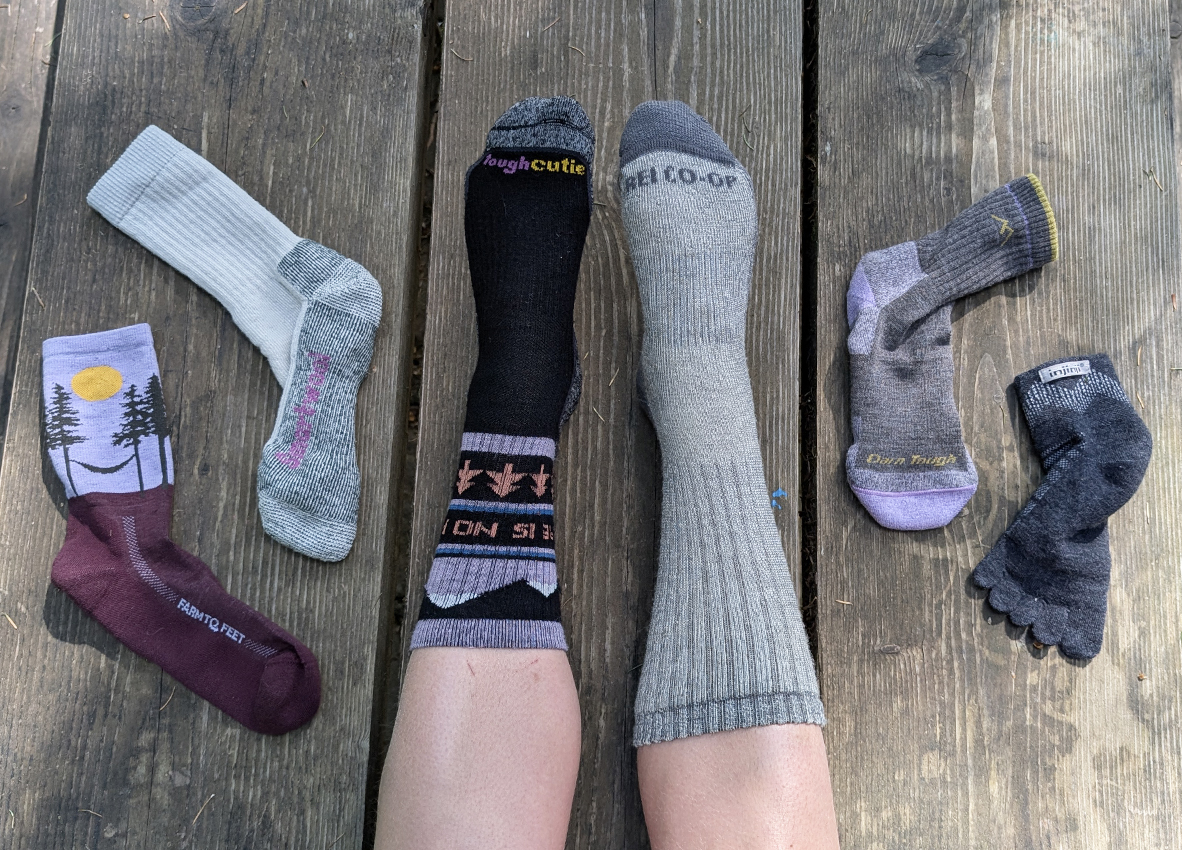We may earn revenue from the products available on this page and participate in affiliate programs. Learn More ›
It only takes one blister on the back of your heel to discover the importance of a good hiking sock. More than almost any other piece of gear in your kit, a quality hiking sock can make the difference between a fun day on the trail with friends and a crippling sufferfest that no amount of moleskin can fix. To help you avoid such a sufferfest, testers and myself tried socks on everything from day hikes to thru-hikes across the country to find the best hiking sock for your next adventure.
↓ Jump to The Rest of the Field
↓ Jump to How I Tested the Best Hiking Socks
↓ Jump to Test Results
The Best Hiking Socks of 2025: My Top Picks
Best Overall: Darn Tough Hike Midweight
Photo by Laura Lancaster
Buy the Men’s
Buy the Women’s
Pros
- Very comfortable
- Excellent warranty
- Durable
- Offers a wide-version of this sock under the brand “Wide Open”
Cons
- Took longer to dry than other socks in this test
Key Features
-
Price:
$26 -
Weight:
Medium -
Cushion:
Moderate -
Height:
Crew
Test Results
-
Skin Feel:
Great -
Dry Test:
25 hours -
Pilling Test:
Excellent
I was curious to see how the hiking socks in this test would fare during the pilling test — where everything went three cycles of hot wash and hot dry to test the durability of the fibers. Some came back with massive pilling, indicating that the fibers were indeed already starting to break down. But one came back looking basically identical to how it did at the onset, and that was the Darn Tough Hike Midweight.
This sock has achieved near legendary status among thru-hikers for durability, comfort, and performance. It’s been the go-to for our testers on the backpacking gear tests, even when they test them head-to-head against other top contenders. In short: the conventional wisdom is that this is the best hiking sock ever made, and my testing only further supports hikers’ allegiance. Most recently, OL’s associate gear editor, Ashley Thess confirmed their lifetime guarantee policy. She had a couple of pairs of four-year-old socks with holes at the ankle (probably from the best ice cleats) that she sent in. Three weeks later, she had brand-new socks.
In the last couple of years Darn Tough has started selling socks targeted at individuals with wide feet and bigger calves under the brand name “Wide Open.” Why they started a new company for the venture rather than just leveraging the existing popularity of Darn Tough is a bit mysterious, but if you need the best socks for wide feet, know that they are essentially the same exact sock. Testers we’ve sent into the field with this sock have raved.
The only ding for the Darn Tough Hike Midweight is that it took longer to dry than other options I looked at. If you are especially sweaty, or traveling through soggier environs, go with the lightweight version of this sock.
Fastest Drying: Farm to Feet Damascus Full Cushion
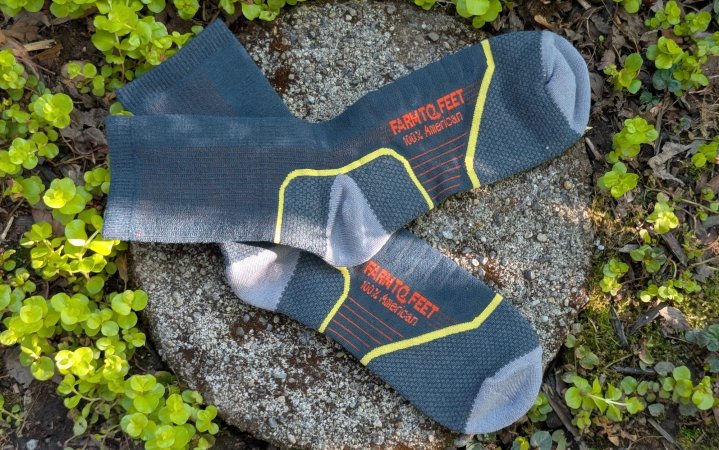
Photo by Laura Lancaster
Buy the Unisex
Pros
- Second fastest dry time in my test
- Made and sourced in the U.S.
Cons
- Skin feel isn’t quite as good as other socks I tested
Key Features
-
Price:
$26 -
Weight:
Medium -
Cushion:
Moderate -
Height:
Crew
Test Results
-
Skin Feel:
Good -
Dry Test:
18 hours -
Pilling Test:
Good
This is a great sock. The Farm to Feet Damascus in Full Cushion dried in a ridiculously short amount of time, taking only one hour more than the Paka Essential Melange. As this is a noticeably thicker sock than the Essential Melange, I’ve ranked it here as the fastest drying in my test.
While the Damascus Full Cushion didn’t have any loose threads catching my toes (an issue with other Farm to Feet socks I looked at), there was noticeable pilling. This one was also a little rougher than other comparable socks, like my best overall pick, the Darn Tough Hike Midweight.
I’ve hiked in Farm to Feet Damascus socks at various times over the years, and always found them to be high performers. While they have a noticeably different approach to top-of-the-foot cushioning compared to other socks in this test, my experience has been that they feel similar to Darn Tough socks.
Something unique about Farm to Feet socks is that in addition to being made in the USA — to be honest, that’s pretty common for hiking socks — it’s also sourced in the USA. That means they are getting their component parts — wool, nylon, elastane — from US-based manufacturers.
Best for Blisters: Injinji Outdoor Mini-Crew
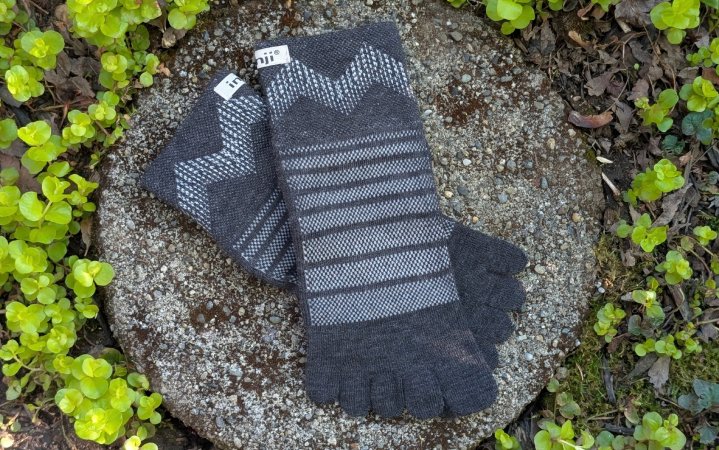
Photo by Laura Lancaster
Buy the Unisex
Pros
- Solid performance across all testing categories
- Helps prevent blisters
Cons
- Feels (and looks) kind of weird
Key Features
-
Price:
$21 -
Weight:
Light -
Cushion:
Light -
Height:
Ankle
Test Results
-
Skin Feel:
Good -
Dry Test:
23 hours -
Pilling Test:
Good
Toe socks are a love-it or hate-it affair. For some people, getting your toes into their own separate compartment can have a myriad of benefits, including blister prevention and improved toe splay. For others, they feel weird and they take forever to get on compared to a typical grab-and-go sock. In this gear tester’s opinion, there’s space for both these takes. If you have problems with in-between the toe blisters, this is absolutely something you should try to see if it gives you some relief.
While Injinji does offer several socks made from only synthetic materials, serious hikers should stick with their wool versions. In my testing, it held its own against powerhouse wool sock companies like Smartwool, Darn Tough, and Farm to Feet.
Best Wool Alternative: Paka Essential Melange
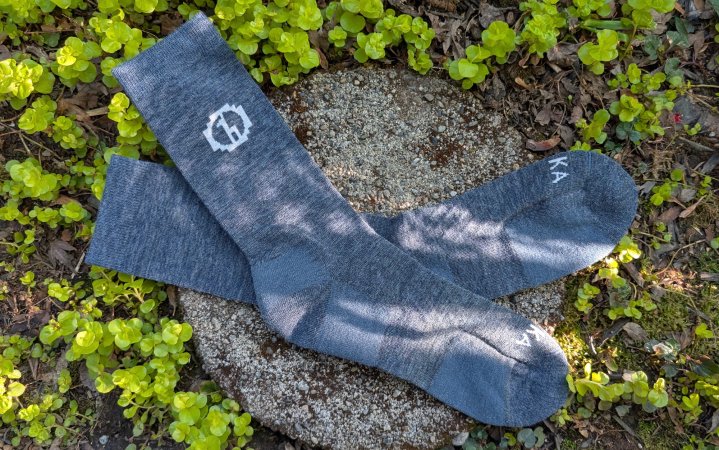
Photo by Laura Lancaster
Buy the Unisex
Pros
- Dried faster than anything else in my test
- Great skin feel
- Ideal if you have a wool allergy
- Great warranty
Key Features
-
Price:
$25 -
Weight:
Light -
Cushion:
Light -
Height:
Crew
Test Results
-
Skin Feel:
Great -
Dry Test:
17 hours -
Pilling Test:
Good
While I wouldn’t recommend cotton, or even synthetic socks, for hiking, there are alternatives to wool to know about — especially if you have a wool allergy. Top among these is alpaca. Alpaca has similar anti-microbial (read, anti-smell) properties. It has similar wicking abilities. It’s very soft. It’s quite strong. While there are fewer of these socks on the market, and the ratio of alpaca content to price is typically more extreme, I was impressed with the Essential Melange from Paka. Not only was it incredibly soft and comfortable out of the box, but it was also the fastest to dry of every sock in my test.
The Paka Essential Melange did struggle more with the pilling test than other socks I looked at. In addition to having noticeable fuzz balls all over (indicating that the fibers were starting to break down), the sock had also shrunk somewhat. I could still pull it on, and I would still wear it, but this is one that you’ll be best served by washing in cool water and hanging to dry.
Best Budget: REI Merino Wool Lightweight Crew
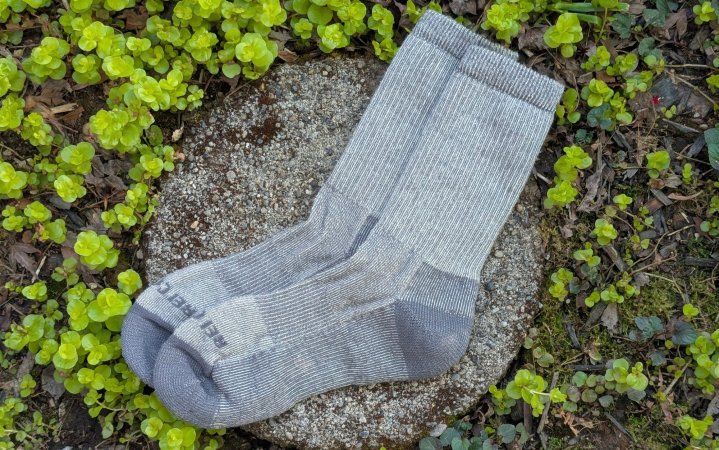
Photo by Laura Lancaster
Buy the Unisex
Key Features
-
Price:
$19 -
Weight:
Medium -
Cushion:
Moderate -
Height:
Crew
Test Results
-
Skin Feel:
Good -
Dry Test:
22 hours -
Pilling Test:
Fair
REI used to have one of the most incredible warranty programs in all of the outdoors: lifetime. Anything you bought from the store, whenever, you could return, no question asked. Sadly, it’s been a few years since that changed (blame rampant and growing abuse of the program), and the current warranty situation over at REI is pretty bleak. After digging around, it’s not clear to me that anything would be covered. Assume if you buy this sock, you’ve got it for however long it lasts — one month, two years, who knows — and then that’s it.
While this sock didn’t have a great performance on the pilling test, it’s so much thicker than your typical “lightweight” sock that you’ll be years breaking down all the fibers holding this one together. I also appreciate, in a world of compression and compression-adjacent socks, that this one has a looser fit that’s not so loose it will fall down.
The Best Hiking Socks of 2025: Also Great
Darn Tough Hike Lightweight
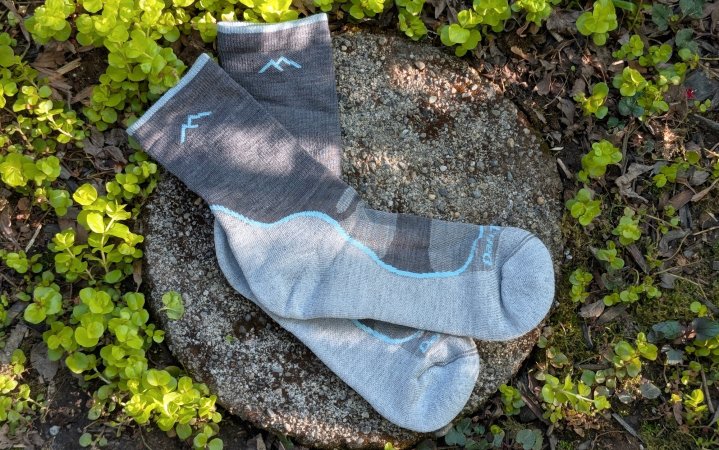
Photo by Laura Lancaster
Buy the Men’s
Buy the Women’s
Pros
- Great warranty
- Dries quick
Cons
- Showed a bit more wear after the piling test than the midweight version
Key Features
-
Price:
$25 -
Weight:
Medium -
Cushion:
Moderate -
Height:
Crew
Test Results
-
Skin Feel:
Great -
Dry Test:
20 hours -
Pilling Test:
Good
The Darn Tough Hike Lightweight and Midweight are both similarly cushioned on the bottom of the sock; the difference is the top, where the lightweight uses a thinner, vent-ier material so that your foot can breathe better. This also means that it had a better performance on the dry test, taking five less hours to dry from a full soak than the Darn Tough Midweight.
Oddly, the Darn Tough Lightweight showed more pilling after three rounds of washing and drying at high heat, despite having a higher proportion of nylon than the Midweight version of the sock. While I was ultimately impressed with both of these, and would whole-heartedly recommend either, most people will get the best value out of the midweight version of the sock.
Farm to Feet Damascus Light Cushion
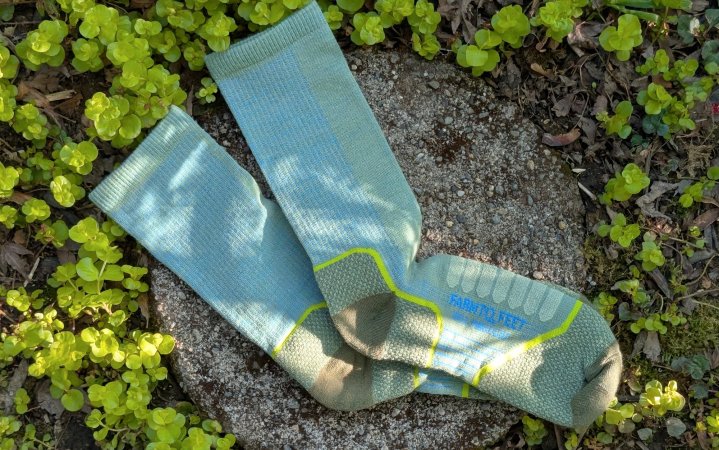
Photo by Laura Lancaster
Buy the Unisex
Pros
- Comfortable
- Great performance on all tests
Key Features
-
Price:
$24 -
Weight:
Light -
Cushion:
Moderate -
Height:
Crew
Test Results
-
Skin Feel:
Good -
Dry Test:
20 hours -
Pilling Test:
Good
The Farm to Feet Damascus Light Cushion is a solid performer, and a great hiking sock. While it didn’t dry as fast during testing as the Full Cushion (oddly), it performed similarly across all other testing categories. If you prefer a lighter sock than the full cushion, then this is a great pick.
Tough Cutie Crew

Photo by Laura Lancaster
Buy the Women’s
Pros
- Loose, comfortable fit
- Cushioned
- Durable
Cons
- Not a great warranty
- No men’s or unisex options
Key Features
-
Price:
$24 -
Weight:
Light -
Cushion:
Moderate -
Height:
Crew
Test Results
-
Skin Feel:
Great -
Dry Test:
24 hours -
Pilling Test:
Excellent
The Tough Cutie Crew impressed testers on our 2023 backpacking gear test, with several commenting that it reminded them of the best qualities of the Darn Tough series. My testing supported that impression, with excellent results in all categories. Unfortunately, this sock, likely in part because it’s a younger company, comes in at the same price point of the likes of a Darn Tough, but not the same best-in-class warranty. If you want to see more competition in the sock area, buy Tough Cutie. Otherwise, Darn Toughs continue to be a better value for the long haul.
Smartwool Classic Crew Full Cushion

Photo by Laura Lancaster
Buy the Unisex
Pros
- Loose, comfortable fit
- Cushioned
- Durable
Cons
- Pricey
- Not a great warranty
Key Features
-
Price:
$23 -
Weight:
Heavy -
Cushion:
Heavy -
Height:
Crew
Test Results
-
Skin Feel:
Good -
Dry Test:
25 hours -
Pilling Test:
Good
If you prefer a sock with a thickness closer to my best budget pick but would prefer something with better durability, then go with this comfy choice from Smartwool. Wearing these two socks side by side, I could not have told you which was which, that’s how similar they are. Where they differ is in the results from the pilling test, and their price point. The Smartwool showed very little pilling, closer to that of my best overall pick than the REI Lightweight, suggesting that it should have a longer lifespan on average (although note that the warranty is only for two years). However, you’ll pay about $5 more for this one compared to other picks on this list.
Smartwool Hike Ankle Targeted Cushion
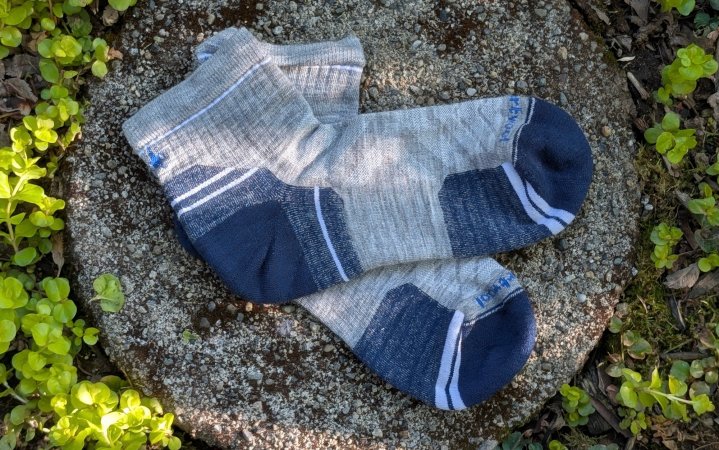
Photo by Laura Lancaster
Buy the Men’s
Buy the Women’s
Pros
- Strong performance across most categories
- Comfortable
Cons
- A little pricey for such a limited warranty
Key Features
-
Price:
$21 -
Weight:
Light -
Cushion:
Moderate -
Height:
Ankle
Test Results
-
Skin Feel:
Great -
Dry Test:
23 hours -
Pilling Test:
Great
If you’ve been disappointed time and again by the no-show socks that just can’t stay up, then consider this ankle sock from Smartwool. It had a great performance in my testing across nearly all categories (although it took longer to dry out then its weight would have suggested), and was still quite soft and comfortable after the aggressive wash/dry cycle of the pilling test. The only real downside here is that Smartwool doesn’t offer the same kind of top-notch warranty as the likes of Darn Tough or Farm to Feet.
Smartwool Hike Mid Crew Light Cushion
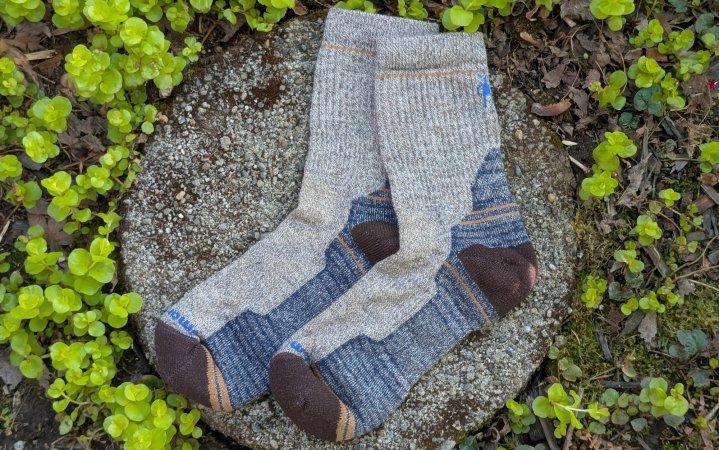
Photo by Laura Lancaster
Buy the Unisex
Pros
- Reasonable testing results across all categories
Cons
- No standout performance in any category
- A little pricey
Key Features
-
Price:
$24 -
Weight:
Medium -
Cushion:
Heavy -
Height:
Crew
Test Results
-
Skin Feel:
Good -
Dry Test:
25 hours -
Pilling Test:
Good
The Smartwool Hike Mid Crew Light cushion is a perfectly serviceable sock, but in a category that is defined by top-tier performances, it struggled to make an impression. There is no problem with this sock, other than that it’s a little pricey for something with such a limited warranty. Buy it on clearance if you find it.
The Best Hiking Socks of 2025: The Rest of the Field
REI Merino Wool Midweight Crew
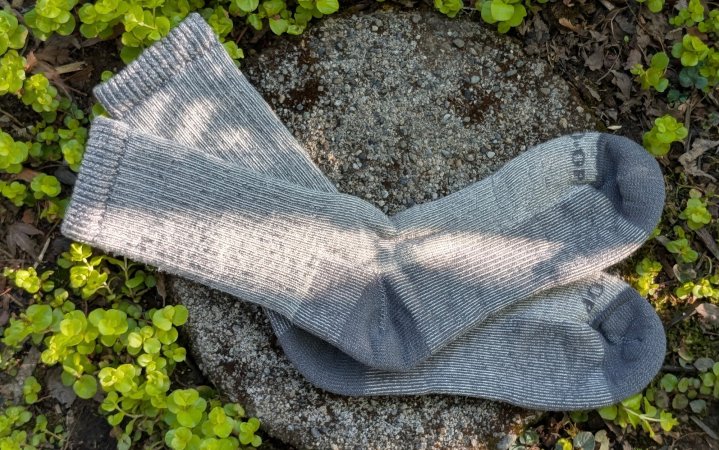
Photo by Laura Lancaster
Buy the Unisex
Cons
- Bulky
- Not a great warranty
Key Features
-
Price:
$20 -
Weight:
Heavy -
Cushion:
Light -
Height:
Crew
Test Results
-
Skin Feel:
Good -
Dry Test:
24 hours -
Pilling Test:
Poor
While similar to the REI Merino Wool Lightweight Crew, the REI Merino Wool Midweight Crew was both thicker than I would have liked and showed more signs of pilling after three rounds of washing and drying on high heat. Stick with the lighter version of this sock unless you have some winter hiking on the books and you’re looking for some extra insulation.
Darn Tough Ultralight No-Show

Photo by Laura Lancaster
Buy the Men’s
Buy the Women’s
Pros
- Great warranty
- Good durability
Cons
- Took forever to dry
- Shrank during the pilling test
Key Features
-
Price:
$19 -
Weight:
Light -
Cushion:
Heavy -
Height:
No-show tab
Test Results
-
Skin Feel:
Good -
Dry Test:
27 hours -
Pilling Test:
Great
I’m forever on the lookout for a no-show sock that performs at the level of the other best hiking socks and actually stays in place. The Darn Tough Ultralight No-Show is a solid entry in this space, but you are sacrificing a bit of performance.
The biggest issue with this sock is that it takes a surprisingly long time to dry for something so-called ultralight. If you are a big-time sweater, this should not be your first pick. It also showed signs of shrinking after the pilling test. While this wasn’t something I was testing for specifically, modern wool garments are designed to be washed at higher temperatures without shrinking, something that cannot be said of wool garments in the past. This one did noticeably shrink. I was still able to comfortably wear it (and tested its stay-put power on a recent run), but if your foot size is closer to the higher end of the scale and you machine dry your wool socks, this could be an issue.
Farm to Feet Asheville

Photo by Laura Lancaster
Buy the Unisex
Pros
- Beautiful design
- Made and sourced in the USA
Cons
- Pilled quite a bit
- Loose threads on the interior
Key Features
-
Price:
$23 -
Weight:
Medium -
Cushion:
Light -
Height:
Crew
Test Results
-
Skin Feel:
Good -
Dry Test:
20 hours -
Pilling Test:
Excellent
The Damascus is Farm to Feet’s flagship sock, so I was excited to try something new from them. The Asheville is a more streamlined sock, with a lovely design of a hammock swinging between two fir trees beneath a summer’s sun on the exterior. Unfortunately, this lovely design left a cacophony of loose threads on the interior. More than once my toes caught the threads when I was trying to pull this one on. This one may well have other durability issues as well, given that it was of the worst offenders for pilling in my test.
Point6 Crew Light

Photo by Laura Lancaster
Buy the Unisex
Cons
- Not as soft as other socks
- No targeted cushioning
Key Features
-
Price:
$23 -
Weight:
Medium -
Cushion:
Light -
Height:
Crew
Test Results
-
Skin Feel:
Fair -
Dry Test:
25 hours -
Pilling Test:
Excellent
I’ve been testing socks for years, and again and again one of the best brands for durability has been Point6. This testing round was no exception. Both their light and ultralight socks came through with flying colors, showing virtually no pilling whatsoever. Unfortunately, both these and other Point6 socks I’ve tried are noticeably less soft than other socks in this test, including those from Darn Tough, Smartwool, and Farm to Feet. They have a slightly abrasive quality to them that can start to feel downright uncomfortable after a long day of trail — noted by our testers on our 2023 backpacking gear test along the sandy Oregon Coast Trail — even with the sock otherwise performing perfectly.
Point6 Crew Ultra Light

Photo by Laura Lancaster
Buy the Unisex
Cons
- Not as soft as other socks
- No targeted cushioning
Key Features
-
Price:
$21 -
Weight:
Light -
Cushion:
None -
Height:
Crew
Test Results
-
Skin Feel:
Fair -
Dry Test:
20 hours -
Pilling Test:
Excellent
The Point6 Crew Ultra Light had a nearly identical performance to the Point6 Light sock, except for a faster drying time. Ultimately, these two socks felt like they had similar weights to me, even though they were performing differently in that key test. If you prize durability over all else and have reasonably tough skin, then this is an excellent choice for your next sufferfest.
Icebreaker Hike+ Crew Light Cushion
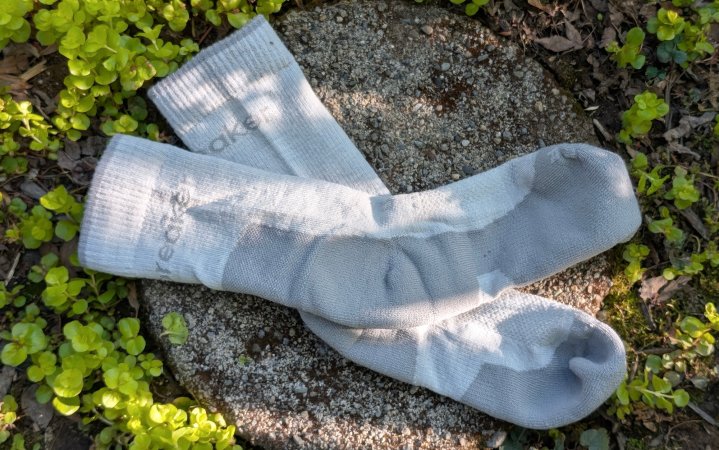
Photo by Laura Lancaster
Buy the Men’s
Buy the Women’s
Cons
- Had threads showing when I opened the package
- Shorter warranty
Key Features
-
Price:
$23 -
Weight:
Light -
Cushion:
Moderate -
Available Heights:
Crew
Test Results
-
Skin Feel:
Great -
Dry Test:
25 hours -
Pilling Test:
Fair
Most socks had to wait for the pilling test for me to get a sense of their durability, but I had concerns about the Icebreaker Hike+ as soon as I opened the package. There were multiple threads showing around the cuff of the sock. The placement and number of these loose threads suggests that the fibers of the Icebreaker Hike+ are more fragile on average. Given that this sock is not especially budget compared to the others on this list, and the shorter warranty period of one year, I suggest you spend your money elsewhere.
How I Tested the Best Hiking Socks
I’ve been testing hiking socks longer than any other category, from my own experience hiking the Pacific Crest Trail to managing a crew of a dozen testers. In that time, it’s become clear what makes for the best hiking sock: comfortable skin feel, fast drying time, a high merino wool content, and best-in-class durability.
For this test, I leveraged my experience and that of the Outdoor Life team to pull together a list of the best hiking sock brands — Darn Tough, Smartwool, Farm to Feet — to put through testing on the factors most important to hikers.
Skin Feel
The best hiking sock is one that you don’t feel at all: no itching, no scratching, no seams in the wrong spot. I tried on each sock at both the start and end of testing to assess how comfortable they were.
Dry Test
Whether you’re sweating up a storm in the desert or hopscotching over mud puddles in the Pacific Northwest, wet feet are an inevitability. But the longer your feet are wet for, the more problems can arise, from blisters to even trench foot. I completely soaked all the socks in this test and then hung them up to dry in a room with 50 percent humidity. I then timed how long it took each sock to fully dry.
Pilling Test
It’s extremely difficult to test the relative durability of socks. Factors that affect a sock’s longevity include the level of grit inside your shoe, how often and how hot of a temperature you wash your socks at, whether you line dry or use a drying machine, how trimmed your toenails are, and more. Field tests of sock durability will be influenced by all these factors, making a true apples to apples comparison difficult to impossible.
Socks get holes when the fibers that make up the sock start to break down. Another sign the fibers are breaking down is pilling, the little balls that appear on a garment after you’ve worn or washed it a few times. To get a better understanding for how quickly the fibers of a given sock are breaking down, I put one sock from each pair through a pilling stress test by running them through a hot water wash and dry cycle three times. I then compared the level of pilling on each with the unwashed sock.
Test Results for the Best Hiking Socks
Things to Consider Before Buying the Best Hiking Socks
While it’s tempting to grab any old pair of socks out of your drawer before hitting the trail, most socks designed for frontcountry life aren’t suitable for outdoor adventures. But sifting through all the different sock styles, from no-show to knee-high, and materials—merino wool, nylon, acrylic, spandex, Tencel, rayon, and more—can make the process of finding the best hiking sock daunting. Here are a few factors to consider before choosing a pair for your next hike.
Materials Used in the Best Hiking Socks
The best hiking socks all use a significant amount of wool. That’s because wool is both extremely effective at moving moisture from your skin to the exterior of the sock, where it can wick (evaporate away). Wool is also an excellent thermo-regulator, helping to keep your feet warm in cold weather, and cool in hot weather. Finally, wool has anti-microbial properties that are far more effective at preventing stink than any of the fancy washes manufacturers put synthetic socks through. While wool has a reputation for being scratchy, today’s sock manufacturers are able to strip away the scales on the fibers that are abrasive, leaving a smooth and comfortable yarn.
Wool, however, is still not all that durable. For that reason, nylon is used, often as a kind of scaffolding, to help the sock stand up to the rough conditions hikers typically put them through.
Finally, to give the sock a bit of staying power, socks use elastane (often under the brand name Spandex) to help the sock from slipping down or bunching up uncomfortably.
Typical Heights for the Best Hiking Socks
It’s tough enough to choose between all of the great socks that are out there, but once you’ve done that you have to figure out what height of that sock you want. Here’s a simplified guide to get you started.
- No-Show: I’ve never tested a pair of no-shows that stayed up while I was walking, let alone running or hiking. True no-shows are a no for me.
- No-Shows with a Tab: These are similar to no-shows, but with a bit of extra material and an extra tab out the back. For some reason, this makes all the difference in terms of a sock’s ability to actually stay up. However, that tab in the back can catch a ton of dirt debris, which, in addition to being annoying, will also rub against the sock and reduce its lifespan.
- Ankle and Crew (aka, 1/4, Micro Crew, Crew, Boot Sock, Mid-Calf): These socks go by many names, but they are all essentially socks that fit part way up your ankle or calf. This is the right sock for the vast majority of people. The shorter lengths may be too short for especially tall hiking boots, while the taller socks may have too-constrictive uppers for juicier calves.
- Over-the-Calf: Over the calf, for most people, is overkill. Pick these up only if you are looking to keep your legs a bit warmer on average (although a better choice would be to pick up a pair of the best puffer pants).
Warranties for the Best Hiking Socks
No sock, no matter how well made, is a buy-it-for-life item. But some sock companies provide generous warranty programs that help to bridge that gap. A few even provide gold-standard return policies that effectively allow you to return socks that have reached the end of their natural lifecycle and to get a fresh pair for free. In addition to detailing the differences between the different warranty programs, we’re also looking into how difficult (and reliable) these warranties programs are to use.
Price Point of the Best Hiking Socks
While an individual pair of hiking socks is (usually) affordable, small differences in price can add up when you need multiple pairs. That being said, I recommend aiming for a sock in the $20-$25 range for everyday hiking. The lifespan of these higher quality hiking socks usually justifies the higher price tag.
Read Next: The Best Hiking Underwear for Women of 2025
FAQs
Hiking socks can cost anywhere from $10 to $60, but the best hiking socks are typically around $20 to $25. Less than that and you are likely to run into durability issues, and you may notice more blisters than you would have otherwise seen. Higher priced socks typically come with extra cushioning, a specialized fiber (like my yak cashmere pick), fine-gauge merino wool, or some other unique performance benefit.
The best hiking socks for sweaty feet are the ones that wick away moisture quickly. Look for socks with a high percentage of merino (or a synthetic that is designed for wicking), and consider what kind of shoes you are planning to pair them with. If you are wearing trail runners, where moisture can easily escape, thinner socks may work better to keep your feet dry. In traditional hiking boots, which can become swampy in hot conditions, thicker hiking socks can help provide a buffer between your feet and the sweat wicking to the outside of the sock.
Socks that are made from 100 percent wool will tend to be less durable than those that are blended with more durable nylon fibers.
Modern wool socks are meant to be worn directly against the skin and should not be itchy. The exception to that is individuals with wool allergies, who will likely still experience wool socks as itchy.
Final Thoughts on the Best Hiking Socks
The above best hiking socks are all great choices for dayhiking and overnighters. Some, like the Darn Tough and Point6 socks, I even pack for multi-night trips and thru-hikes. You’ll typically want multiple pairs of hiking socks, so I recommend buying several different kinds to see what works best with your feet, your shoes, and the types of hikes you typically go on.
Read the full article here

